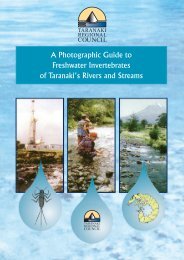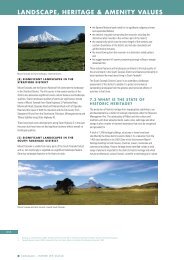Annual report 2006-2007 - Taranaki Regional Council
Annual report 2006-2007 - Taranaki Regional Council
Annual report 2006-2007 - Taranaki Regional Council
Create successful ePaper yourself
Turn your PDF publications into a flip-book with our unique Google optimized e-Paper software.
Glossary of common terms and abbreviations<br />
The following abbreviations and terms are used within this <strong>report</strong>:<br />
Al* aluminium.<br />
As* arsenic<br />
Biomonitoring assessing the health of the environment using aquatic organisms<br />
BOD biochemical oxygen demand. A measure of the presence of degradable<br />
organic matter, taking into account the biological conversion of<br />
ammonia to nitrate<br />
BODF biochemical oxygen demand of a filtered sample<br />
bund a wall around a tank to contain its contents in the case of a leak<br />
CBOD carbonaceous biochemical oxygen demand. A measure of the presence<br />
of degradable organic matter, excluding the biological conversion of<br />
ammonia to nitrate<br />
cfu colony forming units. A measure of the concentration of bacteria<br />
usually expressed as per 100 millilitre sample<br />
COD chemical oxygen demand. A measure of the oxygen required to oxidise<br />
all matter in a sample by chemical reaction.<br />
Condy Conductivity, an indication of the level of dissolved salts in a sample,<br />
usually measured at 20°C and expressed in mS/m<br />
Cu* copper<br />
DO dissolved oxygen<br />
DRP dissolved reactive phosphorus<br />
E.coli Escherichia coli, an indicator of the possible presence of faecal material<br />
and pathological micro-organisms. Usually expressed as colony forming<br />
units per 100 millilitre sample<br />
Ent Enterococci, an indicator of the possible presence of faecal material and<br />
pathological micro-organisms. Usually expressed as colony forming<br />
units per 100 millilitre of sample<br />
F Fluoride<br />
FC Faecal coliforms, an indicator of the possible presence of faecal material<br />
and pathological micro-organisms. Usually expressed as colony forming<br />
units per 100 millilitre sample<br />
fresh elevated flow in a stream, such as after heavy rainfall<br />
g/m 3 grammes per cubic metre, and equivalent to milligrammes per litre<br />
(mg/L). In water, this is also equivalent to parts per million (ppm), but<br />
the same does not apply to gaseous mixtures<br />
l/s litres per second<br />
MCI macroinvertebrate community index; a numerical indication of the state<br />
of biological life in a stream that takes into account the sensitivity of the<br />
taxa present to organic pollution in stony habitats<br />
mS/m millisiemens per metre<br />
mixing zone the zone below a discharge point where the discharge is not fully mixed<br />
with the receiving environment. For a stream, conventionally taken as a<br />
length equivalent to 7 times the width of the stream at the discharge<br />
point.<br />
NH4 ammonium, normally expressed in terms of the mass of nitrogen (N)<br />
97














